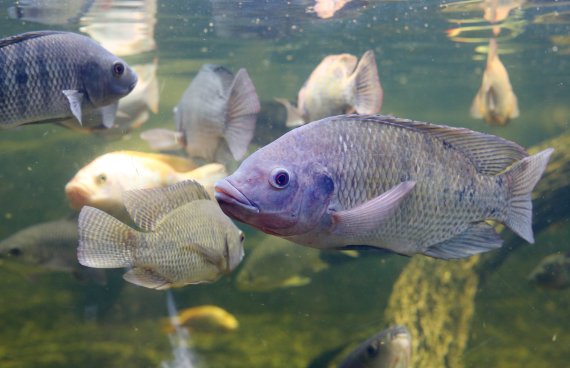The tilapia is an omnivore. © Shutterstock
With fish meal and fish oil becoming increasingly scarce and less sustainable, the fish feed industry is looking at other ingredients. This also means that producers will need to recalculate the composition of the feed. ‘Proteins are the most expensive component’, Haidar explains. ‘Fish have to be fed sufficient amounts to produce fish filets. But you want to avoid the fish using surplus proteins as a source of energy. They have to get that energy from cheaper nutrients, like carbohydrates.’
Feed producers therefore mainly look at the ratio of the digestible proteins to digestible energy (DP/DE). According to Haidar, this is not very precise. ‘For some fish species, the optimal ratio isn’t known. Besides, the various ingredients, which also contain other substances, are not taken into consideration.’
Feathers difficult to digest
Haidar tested the DP/DE model on Nile tilapia, one of the most farmed fish species. The fact that it is an omnivore allows for variations in the feed composition. He discovered that young Nile tilapia in growth do not have an optimal DP/DE. No matter how much protein they are fed, they will convert everything into filets. He also noticed that fish grew better on starch than other types of carbohydrates. He then studied the influence of various ingredients that are often used in fish feed industry, such as feather meal, soy beans and rapeseed. The fish did not digest every substance equally well. ‘As the composition of feather meal isn’t similar to anything the fish would encounter in its natural habitat, it costs more energy to digest the nutrients.’
Pigs
Based on these results, Haidar developed an alternative method to predict the needs of Nile tilapia. This ‘net energy model’, which is also applied in pig farming, considers not only the amount of digestible energy in the feed, but also its composition: proteins, fats, carbohydrates. By analysing the effects of various ingredients in more detail, feed can be produced that the fish can use more efficiently.
Mahmoud Haidar received his doctorate on 17 November. He carried out his research in the Aquaculture and Fisheries group, supervised by Prof. Johan Verreth and Dr Johan Schrama.

